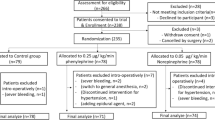Abstract
Purpose
We aimed to investigate the placental transfer of local anesthetics in perfusates with different pH values, using a dual-perfused human cotyledon model.
Methods
The dual-perfused human cotyledon model was prepared from placentas obtained following cesarean delivery (n = 5). Protein-free solution was perfused through both maternal and fetal arteries. Four amide-type local anesthetics (mepivacaine [Mep]; lidocaine [Lid]; bupivacaine [Bup]; and ropivacaine [Rop]) were added to the maternal perfusate at 1 µg·ml−1. Three conditions were tested (stage 1, maternal pH 7.4, fetal pH 7.4; stage 2, maternal pH 7.4, fetal pH 6.9; and stage 3, maternal pH 6.9, fetal pH 6.9). Venous blood samples were collected from the fetal circuit after stabilization. The fetal vein/maternal artery concentration ratio (F/M ratio) of the local anesthetics was used as an index of placental transfer. The concentration of human chorionic gonadotropin (hCG) in the maternal vein was measured at the end of each stage.
Results
The F/M ratios in all stages were in the order of: Mep > Lid > Bup ≒ Rop. The F/M ratios of Mep were significantly higher than those of the other local anesthetics in all stages. The F/M ratios of Lid were higher than those of Rop in stages 2 and 3. The F/M ratios of Lid and Rop were higher in stage 2 than in stage 3. However, the differences between the F/M ratios in the three stages were not as large as expected from the basic uncharged ([B]) condition and pH gap. The concentration of hCG showed a time-dependent decrease with increasing stage (stage 1, 81.0 ± 58.9 mIU·ml−1; stage 2, 57.4 ± 31.8 mIU·ml−1; stage 3, 32.1 ± 19.7 mIU·ml−1).
Conclusion
Our data clearly show that it is the basic uncharged concentration that mainly determines the placental transfer of amide-type local anesthetics with protein-free perfusate. This finding suggests that Rop and Bup can be used more safely than Mep in terms of placental transfer.
Similar content being viewed by others
References
Birnbach DJ, Browne IM. Anesthesia for obstetrics. In: Miller RD, editor. Miller’s anesthesia. 6th ed. Philadelphia: Elsevier Churchill Livingstone; 2005. p. 2307–2344.
Johnson RF, Hernan N, Arney TL, Gonzalez H, Johnson HV, Downing JW. Bupivacaine transfer across the human term placenta. Anesthesiology. 1995;82:459–468.
Johnson RF, Herman NL, Johnson HV, Arney TL, Paschall RL, Downing JW. Effects of fetal pH on local anesthetic transfer across the human placenta. Anesthesiology. 1996;85:608–615.
Johnson RF, Cahana A, Olenick M, Herman N, Paschall RL, Minzter B, Ramasubramanian R, Gonzalez H, Downing JW. A comparison of the placental transfer of ropivacaine versus bupivacaine. Anesth Analg. 1999;89:703–708.
Ala-Kokko TI, Myllynen P, Vähäkangas K. Ex vivo perfusion of the human placental cotyledon: implications for anesthetic pharmacology. Int J Obstet Anesth. 2000;9:26–38.
Burney RG, Difazio CA, Foster JA. Effects of pH on protein binding of lidocaine. Anesth Analg. 1978;57:478–480.
Schneider H, Panigel M, Dancis J. Transfer across the perfused human placenta of antipyrine, sodium, and leucine. Am J Obstet Gynecol. 1972;114:822–828.
He YL, Tsujimoto S, Tanimoto M, Okutani R, Murakawa K, Tashiro C. Effects of protein binding on the placental transfer of propofol in the human dually perfused cotyledon in vitro. Br J Anaesth. 2000;85:281–286.
He YL, Seno H, Tsujimoto S, Tashiro C. The effects of uterine and umbilical blood flows on the transfer of propofol across the human placenta during in vitro perfusion. Anesth Analg. 2001;93:151–156.
Kang L, Jun HW, McCall JW. HPLC assay of lidocaine in plasma with solid phase extraction and UV detection. J Pharm Biomed Anal. 1999;19:737–745.
Tucker GT, Mather LE. Properties, absorption, and disposition of local anesthetic agents. In: Cousins MJ, Bridenbaugh PO, editors. Neural blockade in clinical anesthesia and management of pain. 3rd ed. Philadelphia: Lippincott-Raven; 1998. p. 55–95.
Scanlon JW, Ostheimer GW, Lurie AO, Brown WU, Weiss JB, Alper MH. Neurobehavioral responses and drug concentrations in newborns after maternal epidural anesthesia with bupivacaine. Anesthesiology. 1976;45:400–405.
Santos AC, Karpel B, Noble G. The placental transfer and fetal effects of levobupivacaine, racemic bupivacaine, and ropivacaine. Anesthesiology. 1999;90:1698–1703.
Porter JM, Kellenher N, Flynn R, Shorten GD. Epidural ropivacaine hydrochloride during labour: protein binding, placental transfer and neonatal outcome. Anaesthesia. 2001;56:418–423.
Decocq G, Brazier M, Hary L, Hubau C, Fortaine MR, Gondry J, Andréjak M. Serum bupivacaine concentrations and transplacental transfer following repeated epidural administrations in term parturients during labour. Fundam Clin Pharmacol. 1997;11:365–370.
Burm AGL. Clinical pharmacokinetics of epidural and spinal anaesthesia. Clin Pharmacokinet. 1989;16:283–311.
Kisaka Y. The maternal plasma concentrations, placental transfer and protein bindings of bupivacaine following epidural analgesia (in Japanese with English abstract). Anesthesia and Resuscitation. 1988;24:321–334.
Datta S, Camann W, Bader A, VanderBurgh L. Clinical effects and maternal and fetal plasma concentrations of epidural ropivacaine versus bupivacaine for cesarean section. Anesthesiology. 1995;82:1346–1352.
Simone C, Byrne BM, Derewlany LO, Koren G. Cocaine inhibits hCG secretion by the human term placental cotyledon perfused in vitro. Life Sci. 1996;58:PL 63–66.
Beck T, Bahlmann F, Möbus V. Histometric investigations of placental villi in cases of unexpected fetal acidosis. J Perinat Med. 1994;22:309–317.
Cannell GR, Kluck RM, Hamilton SE, Mortimer RH, Hooper WD, Dickinson RG. Markers of physical integrity and metabolic viability of the perfused human placental lobule. Clin Exp Pharmacol Physiol. 1988;15:837–844.
Author information
Authors and Affiliations
About this article
Cite this article
Ueki, R., Tatara, T., Kariya, N. et al. Comparison of placental transfer of local anesthetics in perfusates with different pH values in a human cotyledon model. J Anesth 23, 526–529 (2009). https://doi.org/10.1007/s00540-009-0815-7
Received:
Accepted:
Published:
Issue Date:
DOI: https://doi.org/10.1007/s00540-009-0815-7




